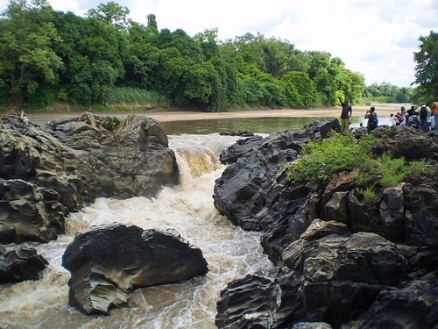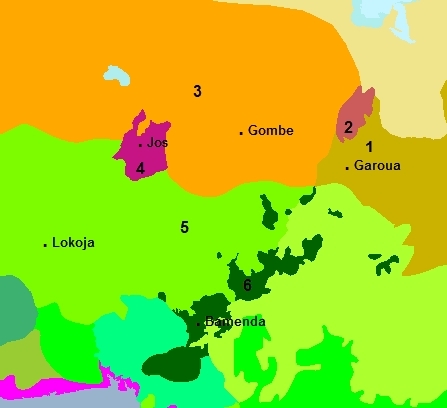Benue River
TheBénué River (alternatively spelled Bénoué) is the chief tributary of the Niger River, and flows a course of 1402 kilometres through northwestern sub-Saharan Africa, chiefly northern Cameroon and eastern Nigeria, prior to discharging to theNiger River near the central Nigerian city of Lokoja.
There is a high level of vertebrate species richness in the Bénué Basin. In the catchment area there is a very high level of plant endemism.
Seasonal flooding is common in the lower Benue Basin, with attendant wildlife invasions of villages, disease outbreaks and loss of life and property.
 Benue River Basin map. Source: K. Musser/Creative Commons
Benue River Basin map. Source: K. Musser/Creative Commons
Basin characteristics
The Bénué (or anglisised Benue) mainstem rises on the Adamawa Plateau in northern Cameroon, and certain tributaries rise in the southeastern mountainous regions of Chad. Major tributaries of the Benue are the Gongola River and the Mayo Kébbi, which connects it with the Logone River when flood-stage is occurring. Other minor tributaries are the Taraba River and Katsina Ala River.
While the mainstem Benue originates in Cameroon, some of the Benue headwater tributaries are born in southeastern Chad. The Mayo Kébbi, one of the primary headwater tributaries to the Benue, is an outlet of Lake Fianga, a surface water body forming part of the national boundary between Cameroon and Chad.
The Bénué River forms a reversoir, Lake Lagdo, as a result of the man-made Lagdo dam, south of the Cameroonian city of Garoua.
After exiting Cameroon, the Benue proceeds west, south of the Mandara mountains, passing the Nigerian city of Yola (Jimeta) to Makudi, prior to discharging to the Niger River at Lokoja.
The mean discharge of the Benue is approximately 2450 cubic metres per second, a level around 36 percent lower than that of five decades ago, when irrigation extraction was at a much reduced amount compared to 2012.
Ecology
|
Ecoregions of the Bénué river basin:
Source: World Wildlife Fund |
East Sudanian Savanna covers the uppermost reaches of the Benue mainstem and its tributaries which boasts extremely high levels of vertebrate species richness
Plant endemism in the upper catchment of the Benue is very high, with typical trees including the Ngálǎma Tree (Anogeissus leiocarpus), Sausage Tree (Kigelia aethiopica), Talh Tree (Acacia seyal) and tree species of Combretum and Terminalia. Grass cover often features the statuesque tussocky Elephant Grass (Cenchrus purpureum).
The East Sudanian Savanna is not typified by high rates of vertebrate endemism, with only one strictly endemic mammal (the mouse, Mus goundae, VU), although this mouse technically resides to the east of the Benue Basin; moreover, the ecoregion has two strictly endemic reptiles (Rhamphiophis maradiensis and Panaspis wilsoni). Several bird species are considered endemic, including one strict endemic, Reichenow's Firefinch (Lagonosticta umbrinodorsalis). Two other near-endemic species, the White-crowned Robin-chat (Cossypha albicapilla) and Long-tailed Cisticola (Cisticola dorsti) are shared with the West Sudanian savanna ecoregion, which lies lower in the Benue watershed.
Amphibians found in the upper Benue Basin within the East Sudanese savanna include the Accra Snake-necked Frog (Phrynomantis microps); the Balfour's Reed Frog (Hyperolius balfouri) also occurs in the upper basin at least up to altitudes of 620 metres and likely higher, but also continuing into the mid-basin. The taxonomically puzzling Banded Banana Frog (Afrixalus fulvovittatus) appears in the upper basin and likely in lower basin elements. The Marble-legged Frog (Hylarana galamensis) is found in the upper Benue Basin as well as in downriver basin segments. The Mottled Shovelnose Frog (Hemisus marmoratus) occurs in the upper basin as well as lower basin of the Benue.
Reptiles occurring in this headwaters region include the African Swamp Snake (Psammophis praeornatus), which is also found in lower parts of the basin. The African Rock Python (Python sebae) is present within the upper Benue Basin. The African Saw-scaled Viper (Echis ocellatus) is found not only in the upper basin but throughout the arid portions of the basin and broadly in West Africa. Adanson's Mud Turtle (Pelusios adansonii) is found in the upper Benue Basin, and continuing into the lower basin, as one of three disjunctive elements of its broad lateral Sahelo-Sudanian range. The Benin Agama (Agama gracilimembris) is also found in the upper basin area. Black-necked Spitting Cobras (Naja nigricollis) are found in the upper Benue Basin as well as lower parts of the basin and widely through sub-Saharan Africa.
 The River Benue near Yola/Jimeta at the western edge of the West Sudanian savanna ecoregion. Source: Leigh Bowden/Creative Commons
The River Benue near Yola/Jimeta at the western edge of the West Sudanian savanna ecoregion. Source: Leigh Bowden/Creative Commons
==
The lower basin of the Benue River can be construed as the region below the joining of the Gangola River at the town of Numan, northwest (downstream) of Yola (Jimeta). In this northern part of this area the terrestrial ecoregion is characterised chiefly by the sprawling floodplain of the West Sudanian savanna, while Guinean forest-savanna mosaic covers much southern part of of the lower basin. Flood stage is not uncommon, as exemplified by recent lower basin flows in the year 2012.
West Sudanian savanna stretches in a band across West Africa south of the Sahel, from Senegal and Gambia to the eastern border of Nigeria. The West Sudanian savanna is a hot, dry, wooded savanna composed chiefly of large tree species and the tall Hyparrhenia grass species (colloquially known as elephant grass) which may be up to three or four metres high.
Sparse woodlands include dry communities, normally less than metres in canopy height, dominated by Anogneissus spp. and accompanied by Acacia spp., Balanites aegyptiaca, Combretum glutinosum, Commiphora africana, Prosopis africana, Tamarindus indica, and Ziziphus mucronata. Elsewhere in the lower basin, wetter woodlands are found with Afzelia africana and Burkea africana dominant. This lower basin is more floristically impoverished compared to the lower Niger basin or Zambezi basin. Moreover, the vertebrate fauna of the lower basin is low in species richness and endemism.
 Benue River in floodstage. Source: NASA 2012 The West Sudanian Savanna possesses relatively few endemic animals in the lower basin, with strictly endemic ecoregion species restricted to two small mammals (a white-toothed shrew, the Cinderella Shrew (Crocidura cinderella), and the Senegal One-striped Mouse (Lemniscomys linulus), eight reptiles, and three amphibians. Two bird species are considered near-endemic: Long-tailed Cisticola (Cisticola dorsti), White-crowned Robin-chat (Cossypha albicapilla).
Benue River in floodstage. Source: NASA 2012 The West Sudanian Savanna possesses relatively few endemic animals in the lower basin, with strictly endemic ecoregion species restricted to two small mammals (a white-toothed shrew, the Cinderella Shrew (Crocidura cinderella), and the Senegal One-striped Mouse (Lemniscomys linulus), eight reptiles, and three amphibians. Two bird species are considered near-endemic: Long-tailed Cisticola (Cisticola dorsti), White-crowned Robin-chat (Cossypha albicapilla).
Guinean forest-savanna mosaic is an interlacing of forest, savanna, and grassland habitat that may be key for speciation. It runs through a portion of West Africa, dividing the Guinean rainforest from the West Sudanian savanna.
Conservation
The Bénué National Park is situated in the upper Bénué Basin in Cameroon. Occupying around 180,000 hectares, this is one of the few sites in West Africa where a Painted Hunting Dog (Lycaon pictus, EN) pack may be seen. This site, also designated as a World Heritage Biosphere Preserve, is one of the only places in Africa where the Giant Eland (Taurotragus derbianus) may be readily spotted.
The Bouba Njida National Park also occurs in the headwaters portion of the Benue Basin within Cameroon. This is also one of the few places where a pack of Painted Hunting Dogs may be seen as well as a wide assortment of antelope taxa.
References
- J..-P. Gosse. 1986. Mochokidae. p. 105-152. In J. Daget, J.-P. Gosse and D.F.E. Thys van den Audenaerde (eds.) Check-list of the freshwater fishes of Africa (CLOFFA). Brussels, MRAC, Tervuren; and ORSTOM, Paris. Vol. 2.
- D.C.D. Happold. 1987. The mammals of Nigeria. Oxford University Press, Oxford. ISBN: 0198575653
- C.Michael Hogan. 2009. Painted Hunting Dog: Lycaon pictus, GlobalTwitcher.com, ed. N. Stromberg
- S.N. Stuart, Richard J. Adams, Martin Jenkins. 1990. Biodiversity in sub-Saharan Africa and its islands: conservation, management, and sustainable use, Biodiversity Conservation Strategy Programme, International Union for Conservation of Nature and Natural Resources. Species Survival Commission, Published by IUCN, 242 pages ISBN 2-8317-0021-3
- M.D.F. Udvardy. 1975. A classification of the biogeographical provinces of the world. IUCN Occasional Paper No. 18. International Union of Conservation of Nature and Natural Resources, Morges, Switzerland.
- F. White. 1983. The vegetation of Africa, a descriptive memoir to accompany the UNESCO/AETFAT/UNSO Vegetation Map of Africa (3 Plates, Northwestern Africa, Northeastern Africa, and Southern Africa, 1:5,000,000). UNESCO, Paris.

